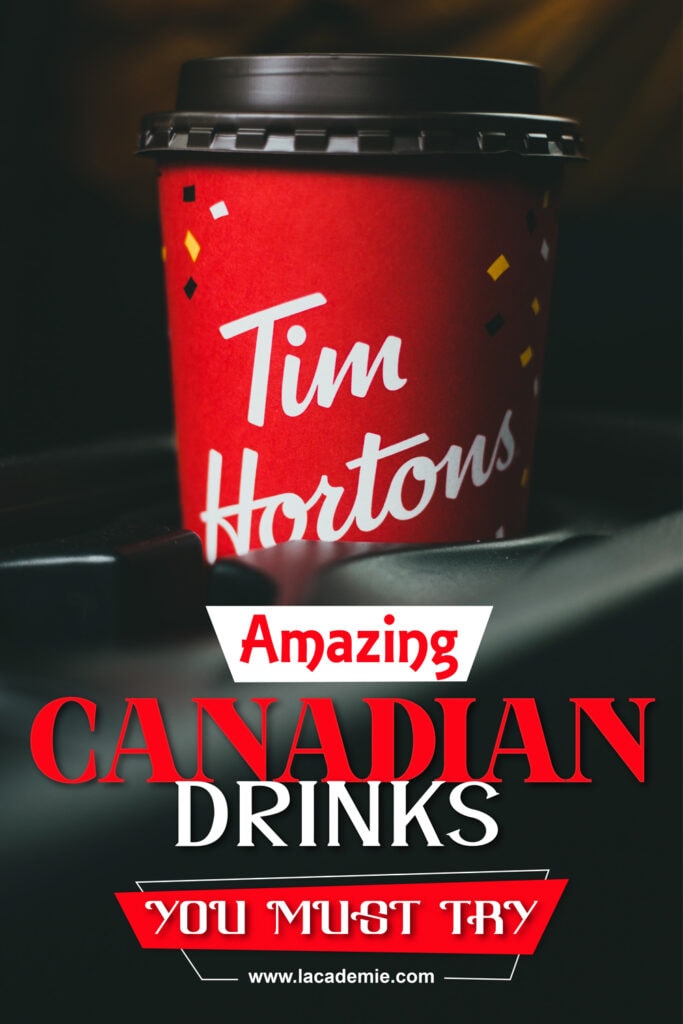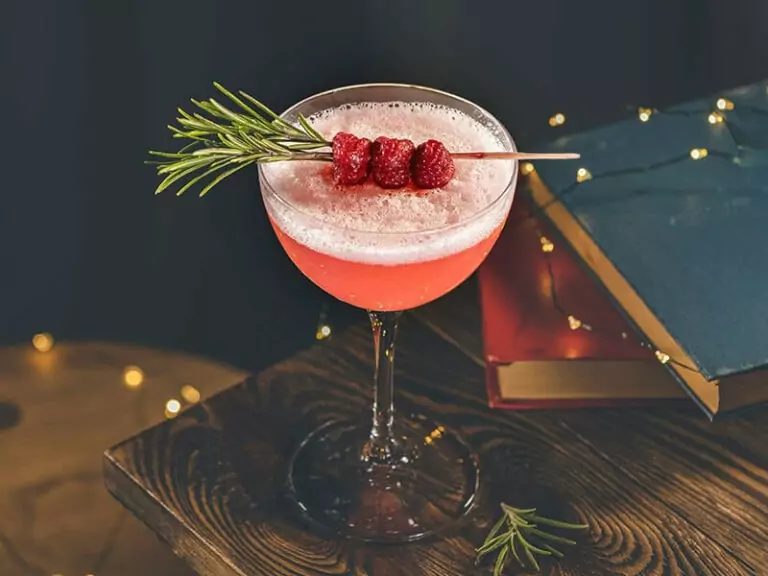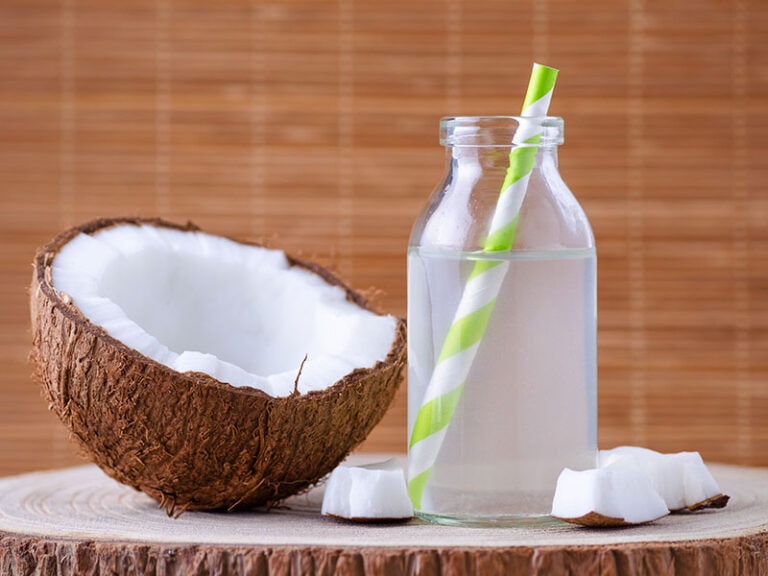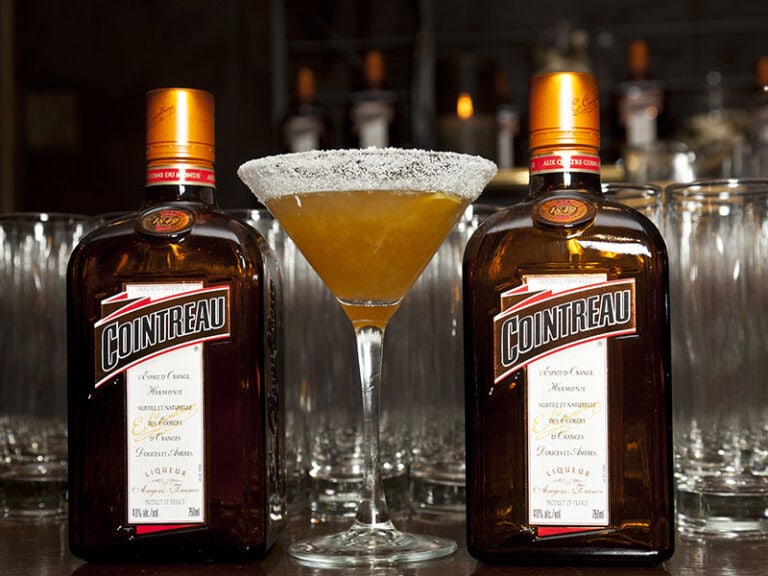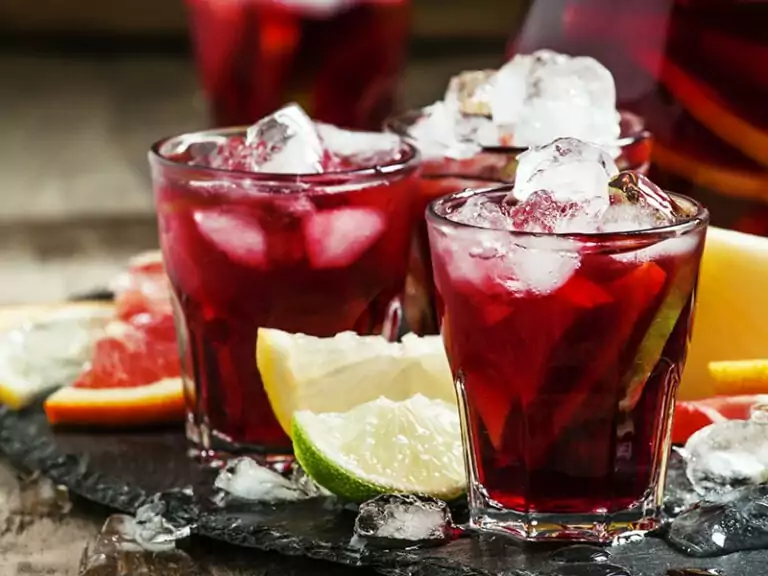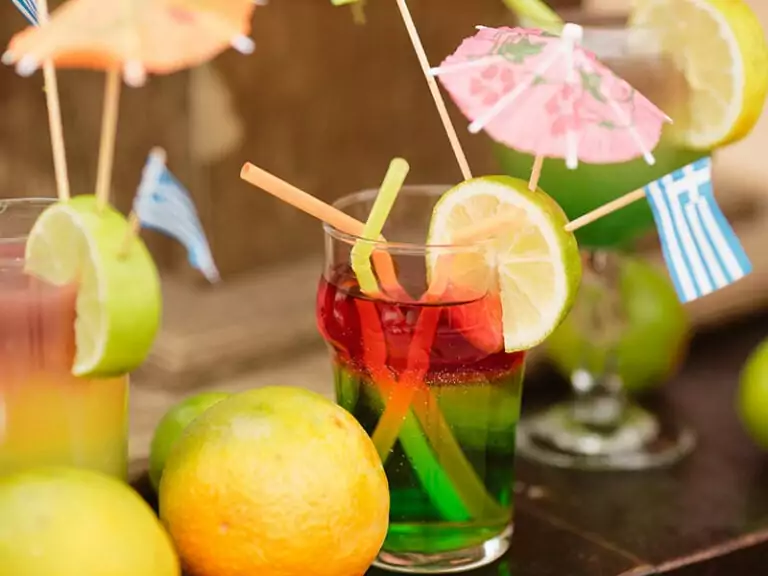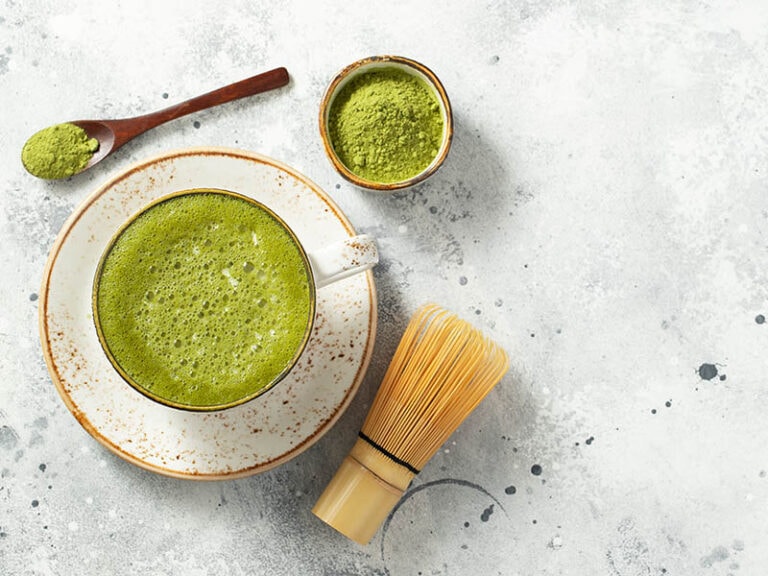People often think that Canadian drinks and food are just the same as the US. One of the biggest reasons is how culturally significant the US is compared to Canada. That is why most people often gloss over Canada.
However, they don’t know that Canada is just as unique and maybe even more diverse when it comes to culinary. Most Canadian dishes have a perfect blend of European, Native American, and many other cultures.
That is why it is my job today to help you discover Canada’s many different types of drinks. In this list, we will be starting with some of the most remarkable and iconic beverages from this maple leaf country. Without further ado, let’s get right into this!
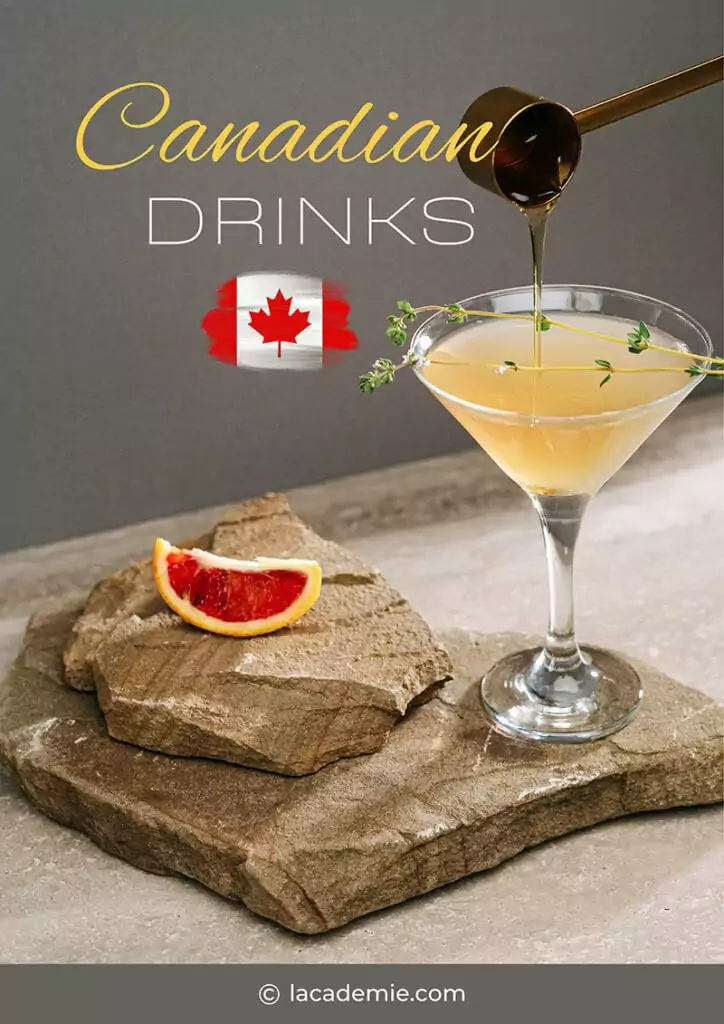
Canadian Coffee and Tea
In the first category, I will introduce you to the coffee-drinking culture of Canada. However, coffee is not only the caffeinated kick Canadians like to have in the morning. Tea is somewhat popular there due to the country being a former British colony. Here are some popular drinks in Cananda.
1. Double Double
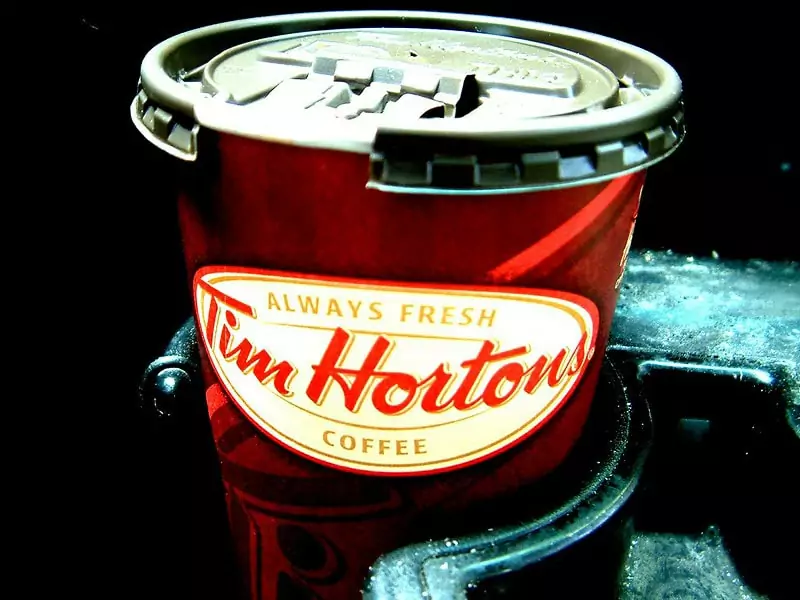
Tim Hortons, also known as Tim’s or Timmies, is a fast-food restaurant chain from Canada. The restaurant mostly serves coffee, waffles, and other popular breakfast items. Since its establishment in 1964, Tim Hortons has become a staple of Canadian life.
Currently, the company has opened at least 4,846 restaurants in 14 different countries, including the US and Europe. Aside from coffee, Tim Hortons also sells tea, hot chocolate, and other types of soft drinks.
Regarding their coffee, Double Double must be the most common choice. It is simply a cup of coffee containing 2 shots of cream and 2 shots of sugar. So double creaminess and double sweetness.
Where to buy: Many Tim Hortons locations are in populated regions like Ontario, Quebec, and Alberta.
2. Swamp Tea
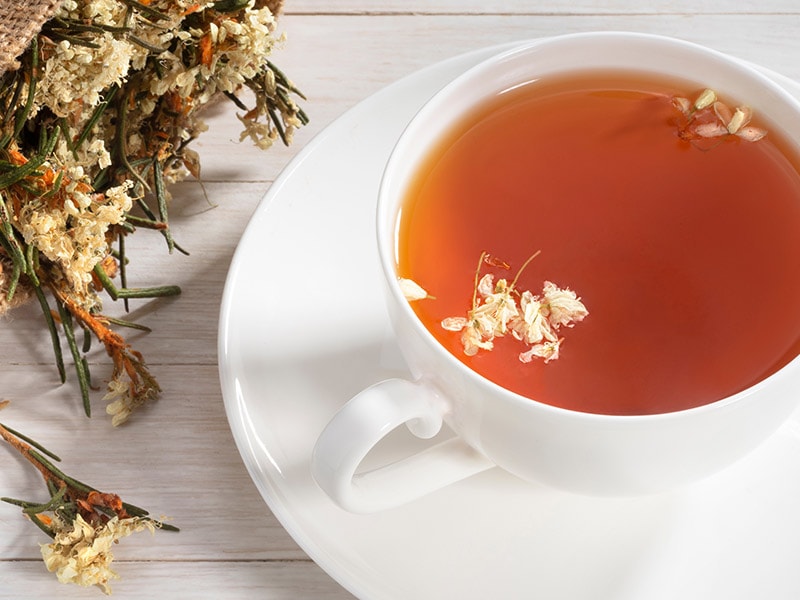
Swamp Tea, or Bog Labrador Tea, has a long history in Canada. Many Native American tribes used to harvest the leaves as a medicinal drink. When European settlers arrived, they began to adopt this drink as a morning beverage.
The plant mostly inhabits regions with many bogs and swamps in Canada, Northern United States, and Europe. The plant’s scientific name is Rhododendron groenlandicum. The tea has many uses, from soothing your sore throat to being a flavoring agent in beer.
In order to make the tea, people have to leave the tea to dry for at least a week. The way you prepare the drink is similar to other types of tea. Just brew it in hot water. The taste is very strong, a little sweet, and citrusy.
Warning: You must dilute the tea with a large amount of water. That’s because a concentrated dose of swamp tea can be very dangerous to drinkers.
Where to buy: You can find the dried version in many online stores. However, if you want to get the freshest leaves, you can find them growing around the Hudson Bay and James Bay regions of northern Ontario.
3. London Fog
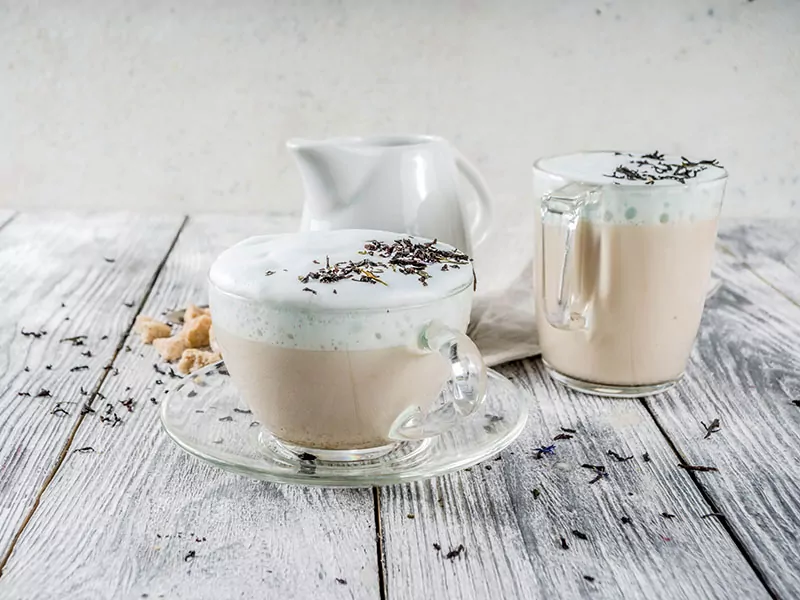
Despite its name, London Fog actually comes from Canada. The origin of this drink is quite unclear. That’s why many people started coming up with their theories. One of the most popular theories is that London Fog came from a woman called Mary Loria.
The story goes that a pregnant Mary Loria ordered this mix at a coffee shop in Vancouver in the 1990s. She also recommended this drink to other people, and the recipe soon spread to many stores.
The main ingredients for the London Fog are Earl Gray tea, vanilla syrup, and milk. If you are lactose intolerant, the London Fog also has versions that substitute milk with other non-dairy alternatives.
The drink is so popular now that it has other versions in several countries, including Scotland and the US. It is very popular in the Pacific Northwest and West Coast in Canada.
Where to buy: You can order this drink at most coffee shops in Canada.
Canadian Soft Drinks and Brands
Instead of looking for tea or coffee, do you want to have soft drinks instead? Here is a diverse list with soda, ginger ale, and even an “anti-energy” drink brand. So just sit back, read through this, and think about what you might order next.
4. Bec Cola
Non-alcoholic
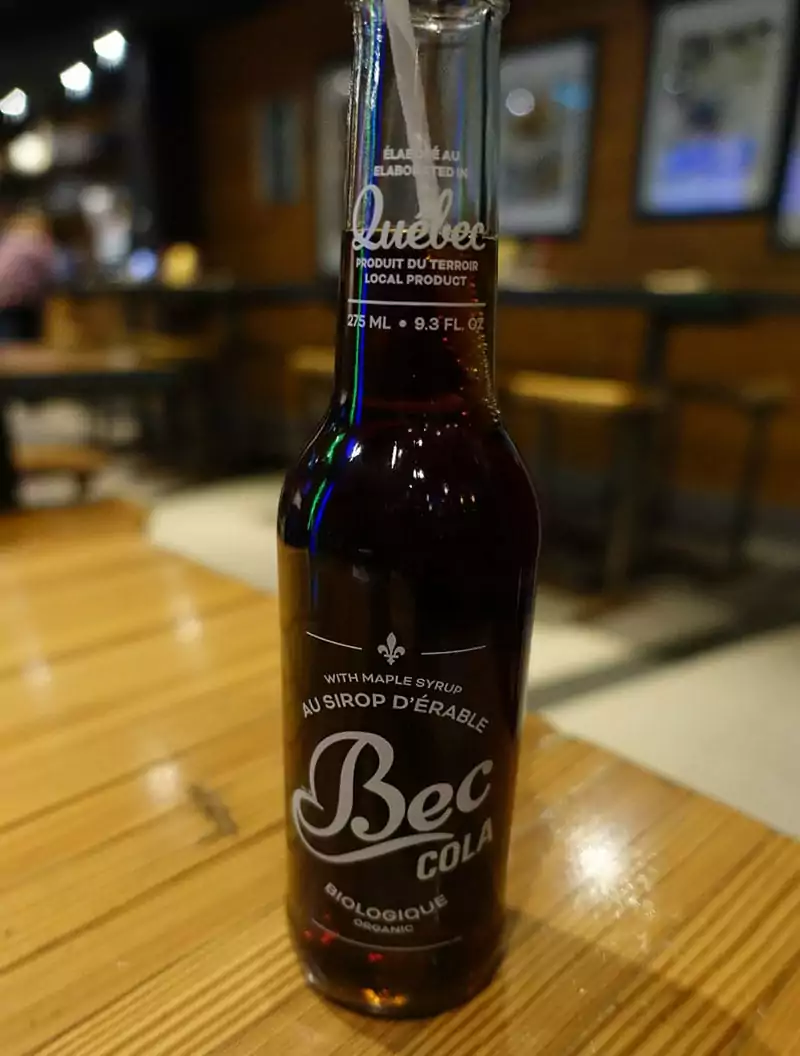
Photo Credit: Bec Cola by Guilhem Vellut is licensed under CC BY 2.0
In 2012, the trio of Olivier Dionne, Gwendal Creuer, and Kevin Creuer came together to create a new type of soda. This new soda will only use organic ingredients. Their goal is to make a far “healthier” soda to compete against big brands that use chemicals.
The final result is the Bec Cola brand that came out after two years of development. The three founders worked with chemists and nutrition advisors to create an entire ingredient list of non-chemical additives during the development phase.
Most of the cola’s flavoring agents are just pure maple syrup. One of Bec Cola’s most important policies is its commitment to using organic products. The company strives to protect the economy and make cola a less harmful beverage.
Thanks to this focus, the company has enjoyed relative success from the consumers. In their first year, the company sold 50,000 bottles. And in the first half of 2016, the company had a record sale of 500,000 bottles.
Where to buy: The cola is available in most organic grocery stores in Canada.
5. Brio Soda
Alcoholic or non-alcoholic
Brio Soda has a history spanning two continents that eventually connect millions of other people.
In 1957, three immigrants from Italy decided to bring a familiar flavor from their home country to Canada. The people call this flavor “chinotto”, which is the extract of an orange fruit from Italy and Malta island.
The three immigrants started importing the “chinotto” drink from Italy. However, they eventually thought that making the drink in Canada would be much better. So instead, in 1959, they imported just the extract and made the drink from a plant in Toronto.
What you have, as a result, is the delicious Brio Chinotto Soda (or Brio for short). Brio was very popular amongst Italian families in Ontario. They see it as a way to feel closer to their homeland. Eventually, the drink soon spread to other communities as well.
Although Brio soda variants like lemon or orange are non-alcoholic, the company has introduced a new “hard Brio” in 2018 that combines traditional Brio soda with vodka.
Where to buy: You can find most Brio from Italian supermarkets in Ontario, Canada.
6. Canada Dry
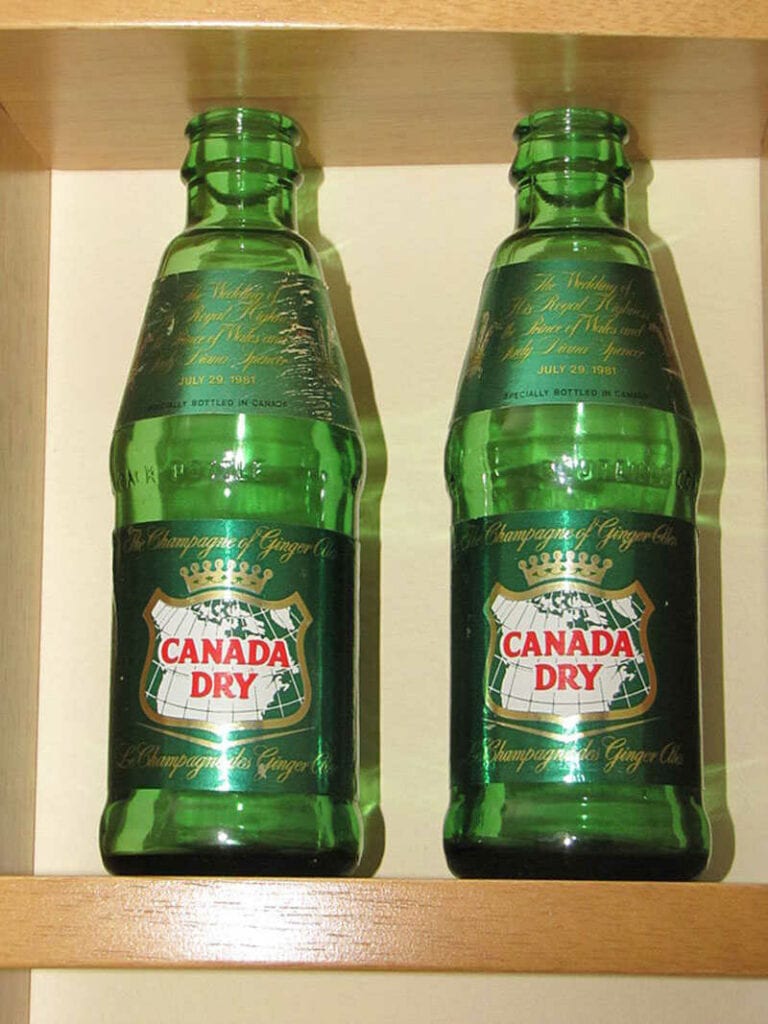
In the late 19th century, a pharmacist named John J. McLaughlin decided to open his first-ever soda plant in Toronto. This is the starting point for the world-renown Canada Dry Ginger Ale. The word “dry” here means a drink with little sugar.
In 1904, thinking about how to make a difference in the competitive ginger ale business, he came up with a new way to make this drink. The Canada Dry felt a lot lighter compared to ginger ale brands at the time. Thanks to this, his brand became popular in North America.
In the 1930s, Prohibition, a period where the consumption of alcohol was illegal, was at its peak. Many people turned to Canada Dry as their go-to drink. The Canada Dry ginger ale brand was also responsible for promoting diet soda consumption in 1954.
With these accolades, it is no surprise that Canada Dry is considered an institution in Canada. Its popularity has helped Canada Dry spread outside of its border. You can see many cans of Canada Dry in Mexico, Europe, and Japan.
Due to its unchanging recipe, Canada Dry tastes less sweet compared to other carbonated drink brands, with a hint of ginger after-taste. Canada Dry also has many ginger ale variants, from blueberry, blackberry, and lemonade.
Where to buy: With a drink as popular and widespread as Canada Dry, you would be able to find it at your nearest supermarket.
7. Sussex Golden Ginger Ale
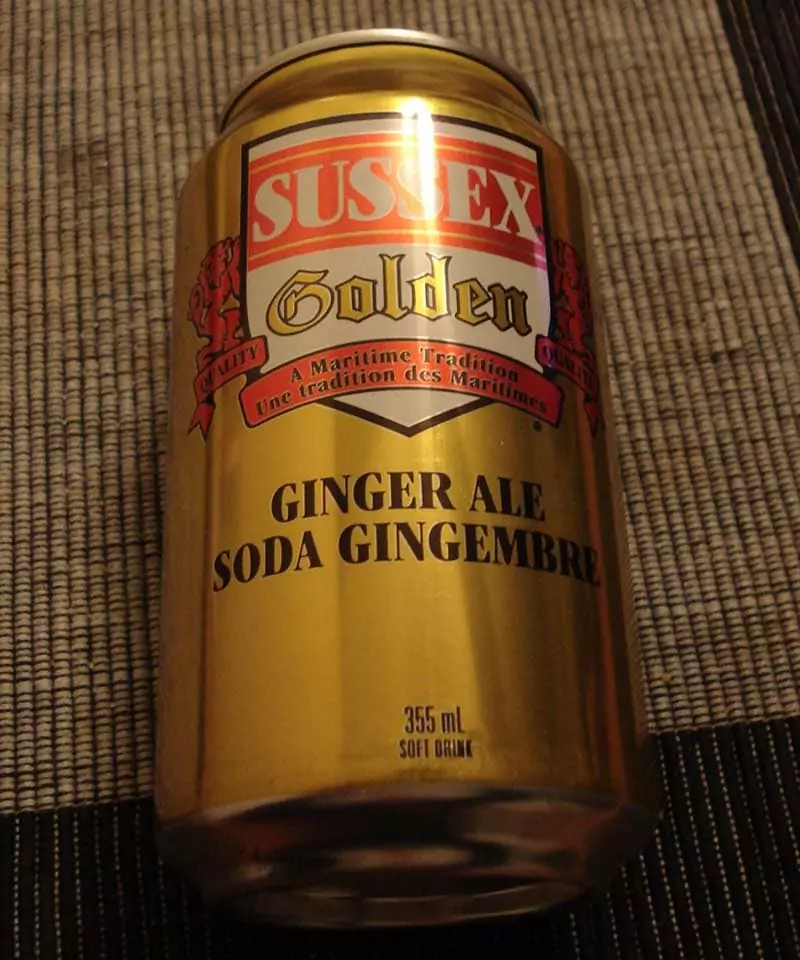
Sussex Golden Ginger Ale represents a big part of the Maritime Provinces.
Despite being a small ginger ale brand, Sussex Golden Ginger Ale has a very long history in the town it originated from, Sussex, Canada. In fact, you might say that within the Maritime Provinces of Canada, it still holds a significant portion in people’s minds.
Let’s look at when the drink was first created: In the late 1890s, Vernon D.W.Rogers developed the recipe for the Golden Ginger Ale with the help of a chemist named Leo John Green. The drink soon became popular and spread all over Canada’s countryside.
Like I said above, due to the rise of Prohibition in the 1920s, the golden ginger ale became overshadowed by the newer dry ale. However, a few companies like Sussex remained loyal to their practice, producing golden ginger ale despite heavy competition.
Compared to the less sweet dry ale, Sussex golden ginger still retains its original flavor. The sweetness is not too overpowering. At the same time, you still have that ginger flavor to keep the drink from being too boring.
Currently, Sussex is starting to branch out into many products, including its own dry ale, ginger beer, and cola.
Where to buy: Since it is a small brand, Sussex Golden Ale is mostly available in the Maritime Provinces on the East Coast and the northern regions of Maine.
8. Spruce Beer
Alcoholic or non-alcoholic
Another interesting drink that comes out of Canada is spruce beer. It is a type of drink that comes from using the buds, needles, and essence of spruce trees. This beverage was the thing that helped Native Americans fight off scurvy, a disease caused by the lack of vitamin C.
That is because spruce essence contains a lot of Vitamin C. Soon, this practice of spruce-infused drinks spread out to sailors and settlers. People started experimenting with putting spruce essence in ale, wine, and beer.
Most of the time, spruce beer means a type of beer that has sugar and spruce flavor. But in Canada, particularly Newfoundland and Quebec, spruce beer can mean non-alcoholic carbonated drink or real alcoholic spruce beer.
In order to make alcoholic spruce beer, most companies boil the essence of spruce along with sugar. Yeast is later added to help ferment the liquid. Sometimes, molasses are a good replacement for sugar in the process.
Where to buy: Spruce beer is rather easy to find in Canada since they’re always available in liquor stores. Plus, Canada has smaller brewers you can seek out.
9. Slow Cow
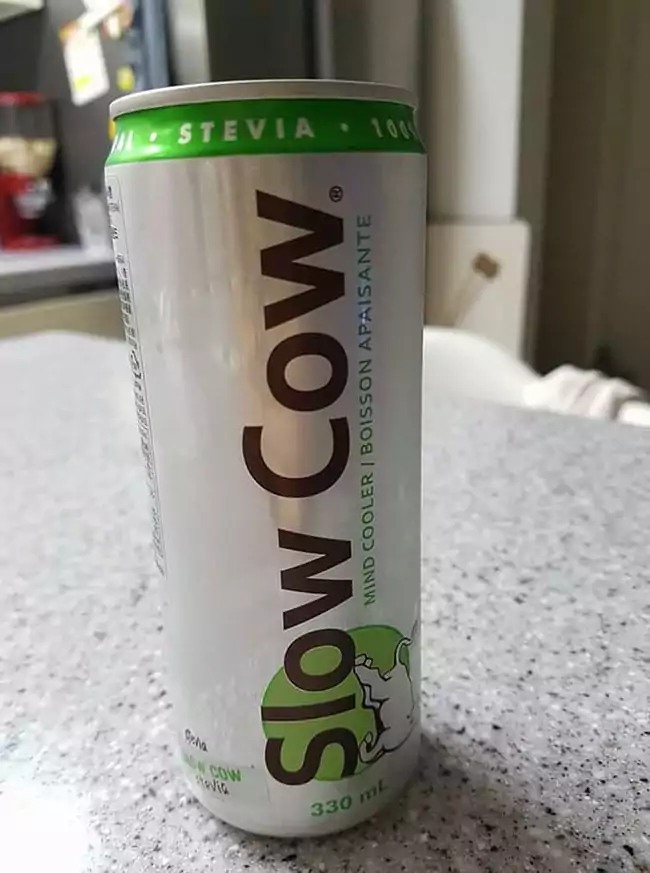
Have you ever had a can of Red Bull before? If the answer is yes, you will understand how much energy the drink gives you. However, with Slow Cow, it gives you the opposite effect. Thus, many have referred to the drink as an “anti-energy” drink.
Slow Cow Drink Inc., the company behind Slow Cow, has its headquarters in Quebec, Canada. The drink came out in 2008, intending to help people slow down and recharge their energy.
The creator of this drink, Lino Fleury, said that he wanted to make a drink that would relax its drinkers. He and his team decided to research organic substances that will calm a person. And the result was an entirely new drink on the market.
Not stopping at that, when the drink came out, the packaging was very similar to that of Red Bull, causing Red Bull’s company to threaten Lino and his team. However, Lino was very confident that his product was legal.
Slow Cow has a very mild flavor when it comes to taste. It’s almost as if you’re drinking a spiced cup of sparkling water. Although this might sound boring, it actually fits the theme of this drink of helping you wind down.
Where to buy: Slow Cow is available at grocery stores across Canada. You can order the drink online as well. The company has also exported the drink to many other countries.
Canadian Cocktails
Canada has a huge cocktail culture. You can find many bars that serve you creative cocktail mixes. However, I think that you don’t have to go too wild to have a good cocktail in Canada. Here are some simple but popular Canadian cocktails you might want to try.
10. B-52
Alcoholic
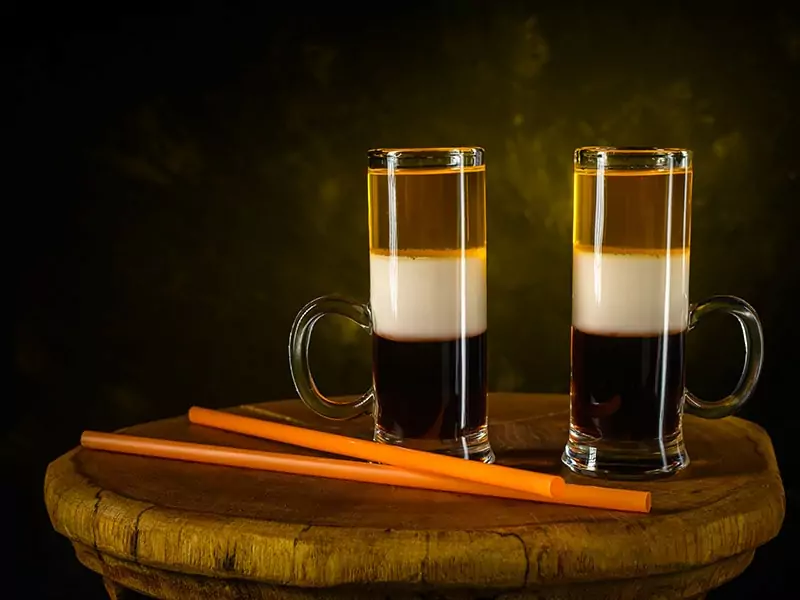
First, we have a popular cocktail that might look like a delicious Canadian dessert. Nobody knows the exact history of the B-52 cocktail. But according to popular belief, the drink was invented by a bartender named Peter Fich at Banff Springs Hotel in Alberta.
Fich had a habit of naming his drinks after his favorite musicians, so the B-52 got its name from a well-known 70s band. Out of Fich’s first customers, one owned a restaurant chain, and that customer decided to put B-25 on his restaurant’s menu.
The main ingredients for the cocktail include coffee liqueur (a mix of spirit and other flavoring agents), a shot of Irish cream, and orange liqueur. Due to these ingredients, the drink is rather sweet, with a hint of bitterness from the coffee liquor and tanginess from the orange liqueur.
Most of the time, the bartender will serve this drink in a small shot glass. Fun fact, outside of Canada, B-52 became the go-to drink for many North Londoners when Arsenal striker Nicklas Bendtner switched his shirt number to 52, earning himself the nickname “B52” in the process.
There is a special variant of B-52 called “Flaming B-52”. In this version, the top of the drink is lit on fire.
Where to buy: Most of the bars in Canada will serve you this drink since it’s on the menu.
11. Toronto Cocktail
Alcoholic
If the sweetness of the B-52 is not to your liking, I want to introduce a more “mature” cocktail you might want to try. Toronto is one of the oldest cocktails in Canada today.
The origin of this drink dates back to the 1920s. The recipe of the cocktail appeared in a book written by Robert Vermeire. The drink used to be called Fernet Cocktail. He said that the drink was popular with many Torontonians in the book.
In 1930, the recipe reappeared again in a book by William Boothby. He named the drink “Toronto” instead of the old name this time.
The ingredients of Toronto consist of whisky, Fernet-Branca (a type of bitter Italian spirit), and maple syrup. The drink has a mild bitterness, with a little sweetness and a slight kick from the whiskey. If you’re still new to a little harder cocktail, this will be the perfect drink for you.
The drink will usually come in a shot glass or a tall cocktail glass if you order it at a bar.
Where to buy: This drink is one of Canada’s staple cocktails, so you can find it at various Canadian bars.
12. Caesar
Alcoholic
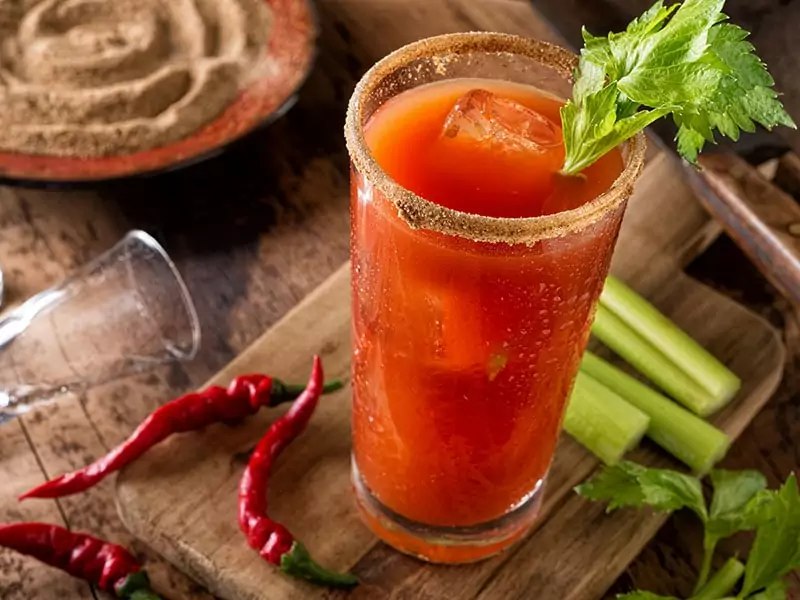
You probably heard of the Bloody Mary, but there is also another popular “bloody” drink called Bloody Caesar. The drink is so popular in mainstream Canada that a petition in 2009 asked the drink to be named Canada’s national mixed drink.
The drink is very unique because it combines the kick of a normal alcoholic drink with a new savory flavor. The main ingredients include vodka, a caesar mix (a combination of tomato juice and clam broth), Worcestershire sauce, and hot sauce.
This strange mix results in a drink you have never seen before.
The creator of Caesar was Mr. Walter Chell, a restaurant manager at Calgary Inn (today, the Westin Hotel). He based his creation on the Bloody Mary, but with the added hot sauce for a more intense flavor.
Once he served this drink to his customer, it became very popular. Soon, it became a Calgarian staple. Its popularity was due to having a strange flavor that captured the tastebud of most drinkers.
Bloody Caesar also has many variants, replacing vodka with gin or rum. However, none will have the same uniqueness as the traditional Caesar.
Where to buy: You can find this drink in almost every bar in the city. Other cities will have a variant of it, but it’s best to taste it where it belongs.
Canadian Alcoholic Drinks
Not only a big market for cocktails, but Canada is also home to many of their own distilled alcoholic beverages. Many Canadian brewers add their own touches to make the beverages more unique. Here are some of the most notable distilled alcoholic drinks in the country.
13. Newfoundland Screech
Alcoholic
With a name like that, you will immediately know that this drink has a big part of Newfoundland, which is in the Northeastern part of Canada. It is a type of rum that has 40% alcohol content. The rum traces its origin back to the island of Jamaica.
According to the company that sells the product, an American soldier decided to order the drink when he was in the region. After downing the rum with one big gulp, he screamed really hard, causing a fellow soldier to exclaim: “What the cripes was that ungodly screech?”
And that was the moment the drink had its name. And don’t worry, the rum might not sound as bad as that American soldier described. If you ever have a chance to taste it, you will find that Screech has a very sweet hint of both caramel and chocolate.
Fun fact: Did you know that a tradition involved Screech? The name of that tradition is “Screech-in”. Screech-in varies in different towns and regions of Newfoundland, but it will always have two things: Newfoundland Screech and a cod.
The Screech-in ceremony takes place to welcome foreigners or people from other parts of Canada. First, you make a toast with Screech. Then you need to say a few words. The final step is to kiss the cod on the mouth. It’s a show of Newfoundlanders hospitality.
Where to buy: The Screech is available at liquor stores in and out of Newfoundland. The rum is also popular in New England.
14. Ice Cider
Alcoholic
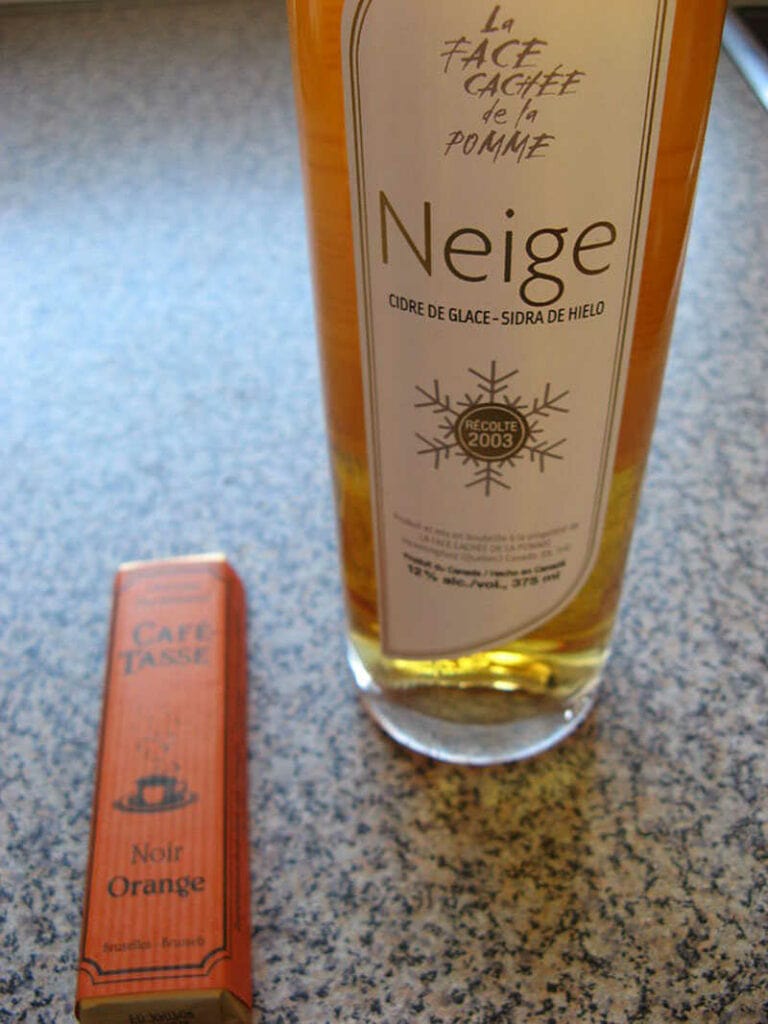
As a representative of Acadian foods and culture, ice cider, or cidre de glace in French, has a Quebecois identity. The drink has a high concentration of alcoholic content due to its fermentation method.
The origin of the ice cider dates back to 1989 when the “father of ice cider”, Christian Barthomeuf came up with the recipe. Thanks to Quebec’s colder climate, the drink became very popular with winemakers because the process is relatively easy.
The main ingredients for ice cider are high-quality apples, including Spartan, McIntosh, Cortland, and Empire.
To create a great glass of ice cider, the maker uses one of these two processes:
- Cryoconcentration: In the winter, apple juice will stay in outdoor containers for 6 months. The drink will slowly freeze over. Once the fermentation is done, the winemaker removes all of the ice inside. The result is a very concentrated alcoholic drink.
- Cryoextraction: The winemaker will harvest frozen apples in the winter, press them to get the juice, and ferment the apple juice for 8 months. This method requires a lot of effort because producers will need a lot more apples than Cryoconcentration.
Nowadays, there are over 60 producers of the drink, from other regions of Canada to Europe and the United States. The drink has an intense sweetness due to the concentrated sugar in apples. People have it alongside cheese and cured meat to balance the taste.
Where to buy: Ice Cider is sold in many liquor stores in Canada. The drink is also available if you want to order it online.
15. Yukon Jack
Alcoholic
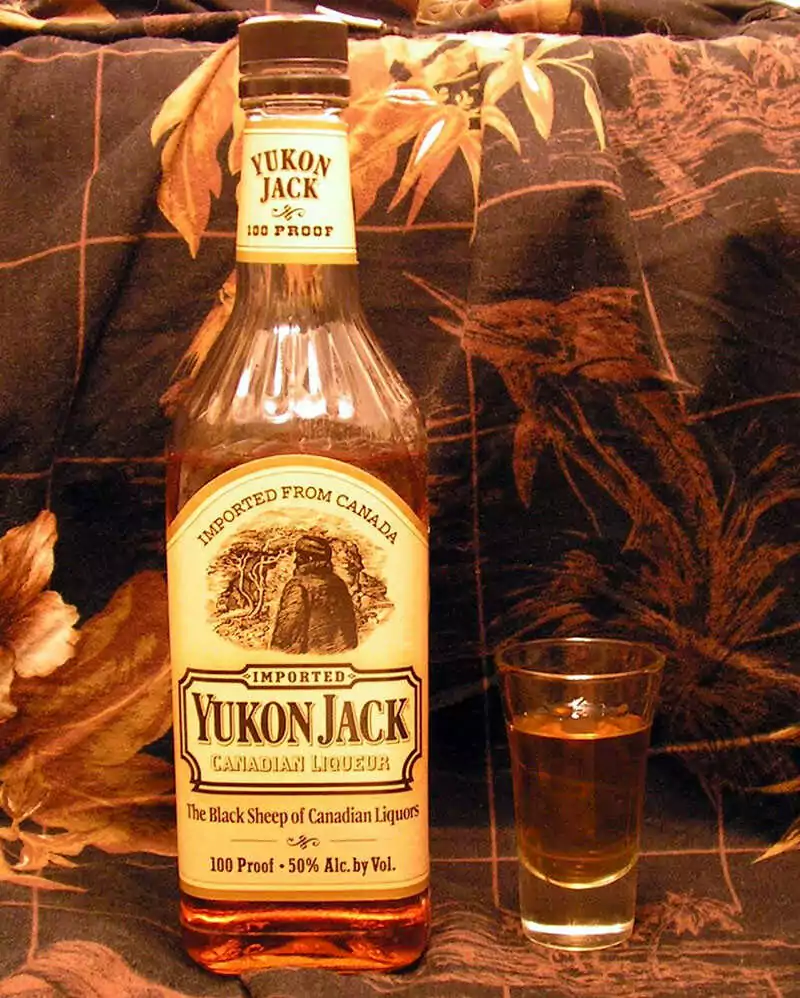
Yukon Jack, being the outlier of most Canadian alcoholic beverages, Yukon Jack seems to be doing really well when it comes to public recognition. Due to the making process, Yukon Jack has a very high alcoholic content.
The name of the drink comes from a famous Canadian pioneer named Leroy Napoleon ‘Jack’ McQuesten. The nickname for Yukon Jack is “The Black Sheep of Canadian Liquors”.
No one knows the exact history of Yukon Jack, but the drink already appeared around the North American region as far back as 1946. Currently, the main producer for this drink is Sazerac Company in Quebec.
The popularity of Yukon Jack has made the drink the centerpiece of many ceremonies. The drink has a very strong flavor due to its whisky base. The honey also adds a bit of sweetness to the drink, preventing it from being too irritating for your throat.
Where to buy: You can get Yukon Jack in a lot of liquor stores in Canada. Yukon Jack’s online store also sells many variants of the drink.
This review of Yukon Jack can give you a clearer picture of what it tastes like.
16. Canadian Club
Alcoholic
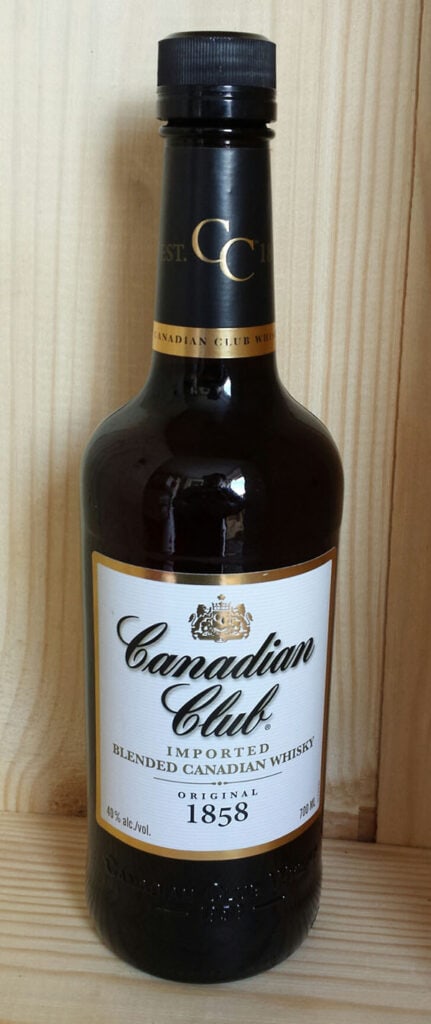
The Canadian Club is a popular brand of whisky. The original maker of this whisky is Hiram Walker. He started his production plant in Detroit in 1858. However, due to the rise of Prohibition sentiment in the US, he decided to move his factory to Windsor, Ontario.
Hiram first learned how to distill cider vinegar in his grocery store in the 1830s. He would soon move on to distilling whisky and opening his own plant in 1854.
One of the most notable things about the Canadian Club is its marketing. In 1967, the company organized a “Hide A Case” campaign that encouraged its drinkers to find hidden cases worldwide. These cases often hid high-quality Canadian Club bottles.
The Canadian Club has a very good whisky taste. When you take a little sip, you can already feel a sort of almond and spicy after-taste. The drink also has a hint of both oak and vanilla.
You can drink it neat (which means it has nothing mixed inside) or make a cocktail out of it. There are many versions of Canadian Club sold outside of Canada, including Classic, Rye, and Apple.
Where to buy: Canadian Club is popular in most clubs and bars, so you won’t have a tough time finding this drink at all.
17. Ice Beer
Alcoholic
Ice beer is another one of Canada’s most popular alcoholic drinks. So what is ice beer exactly? In order to understand the beer, we must first understand the process of making the beer. Most ice beer has to undergo something called “fractional freezing.”
With fraction freezing, the maker freezes the beer to -173.2 degrees Fahrenheit (-114 degrees Celsius), which is the freezing temperature of ethanol. This process creates ice crystals in the beer. Once all ice crystals are gone, the beer inside will have higher alcohol content.
Ice beer is actually quite new compared to many staple alcoholic drinks in Canada. The first ice beer brand to appear in the country was German’s Eisbock in 1989. Both Molson and Labatt followed suit with their own versions of ice beer in Canada.
Some of Canada’s most well-known ice beer brands are Carling Ice, Black Ice, and Busch Ice. Despite its popularity in Canada, ice beer still faces some scrutiny in the US due to its higher alcoholic content.
Where to buy: Ice beer is available across many grocery stores in Canada because it is a popular beverage.
18. Caribou
Alcoholic
Another perfect drink that goes well with other tasty Canadian foods is Caribou. Even though Caribou is categorized as a type of liquor, the drink resembles a cocktail instead. The main ingredients are usually red wine, a spirit of your choice, and maple syrup (or sugar).
The main reason the drink is called Caribou is that people used to use real caribou blood to mix the drink with. However, due to food safety reasons, the redness these days comes from red wine instead.
In Quebec, Caribou is a very popular beverage in the winter. You can find it at the Quebec Winter Carnival and National holiday. People drink Caribou out of an ice glass at the Festival du Voyageur in Winnipeg, Manitoba.
Due to the maple syrup, the drink has a very sweet taste. The mix of red wine and spirit also adds a bit of a kick to the drink. Depending on Caribou’s place, the bartender will add in cloves and nutmeg.
Where to buy: The drink is a popular beverage in Quebec in the winter. If you ever visit a winter carnival, make sure to check out their bar section.
19. Pur Vodka
Alcoholic
Vodka is not only a signature drink of Russia, but many other countries have also been creating their own version. Being very geographically similar to Russia, Canada is a prime example of this.
Canada has so many different vodka brands, but the one I’m going to talk about right now is very special. Thanks to its high-quality and locally sourced ingredients, Pur Vodka has received a total of 83 awards since its release.
These include a master’s award at World Vodka Masters, double gold medals at San Francisco World Spirits Competition, and 30 more gold medals at other competitions.
The creator of Pur Vodka, Mr. Nicolas Duvernois, developed his drink when he was only a janitor. Thanks to the drink, he became one of the world’s leading young entrepreneurs and a rising vodka brand owner.
The drink has a very light hint of butterscotch and vanilla. Aside from that, you can detect a bit of spiciness. The drink gears towards a younger crowd, so it helps to make it a little less bitter and concentrated.
Where to buy: Bars usually use Pur Vodka as a cocktail mix. You can also buy a bottle through their online stores.
The Wonderful World Of Canadian Beverages
Whether you want to choose alcoholic or non-alcoholic drinks, Canada is the place that has it all. Like I said above, the combination of many cultures has created one of the best beverage markets in the entire world.
Through this list, I hope that you can understand how diverse Canada is when it comes to drinking. The country has some of the best beverages in the entire world. And one day, these beverages will be able to stand on their own to represent the quality and value of Canada.
Please give this article a big thumbs up if you like what you read. And don’t forget to share this article on your social media accounts so others can see it as well.
